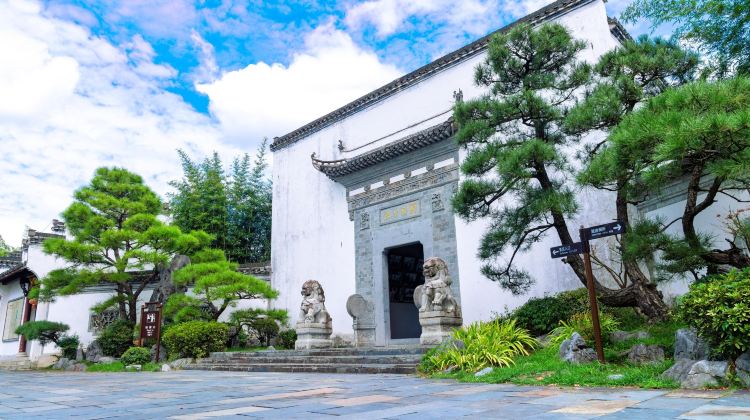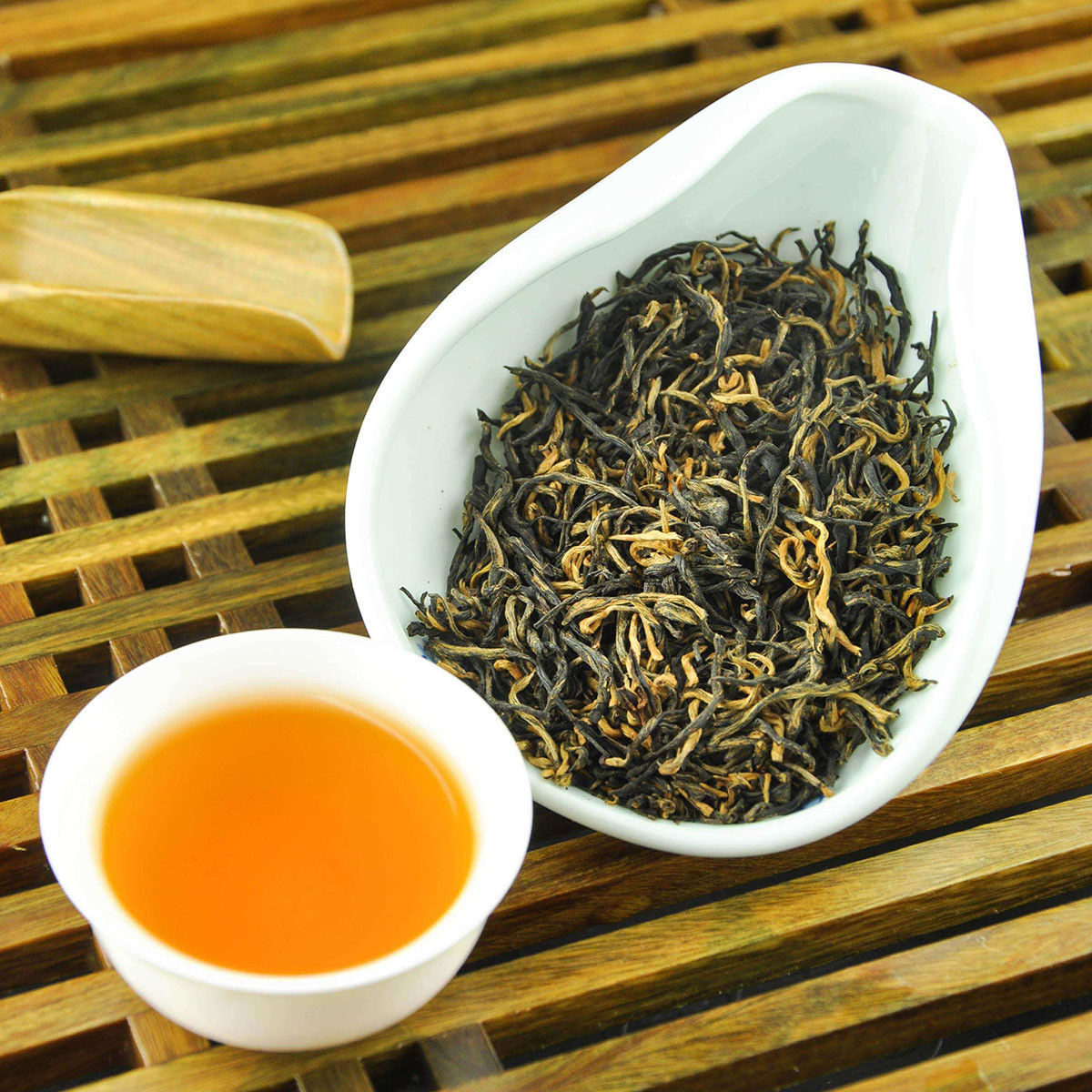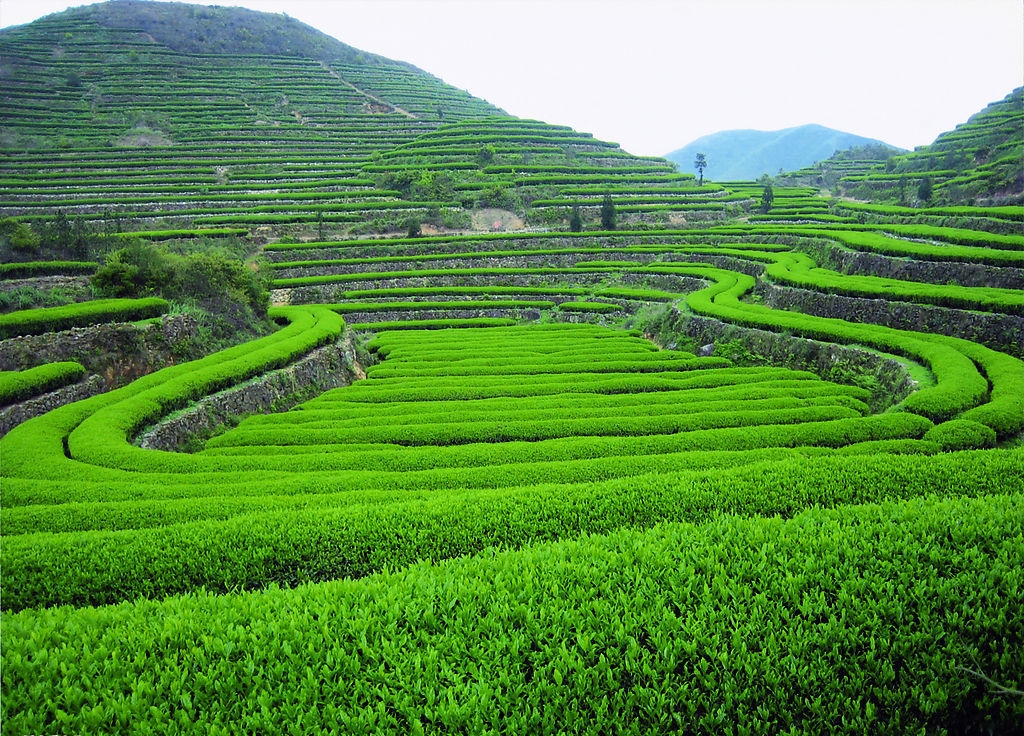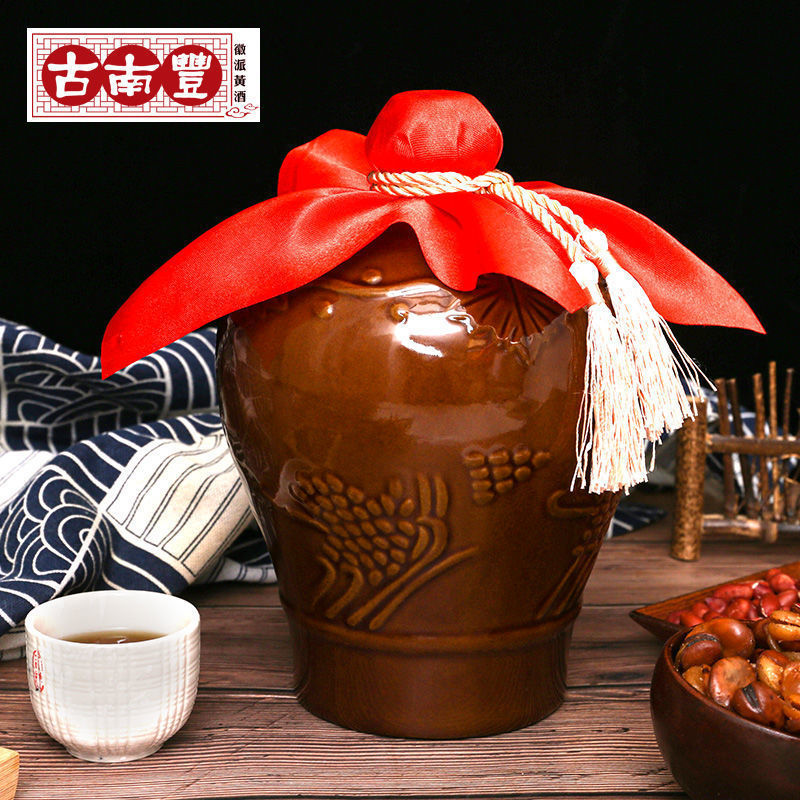
Deutsch-Chinesische Enzyklopädie, 德汉百科
 Anhui Sheng-AH
Anhui Sheng-AH

 Anhui Sheng-AH
Anhui Sheng-AH
 Gelber Tee
Gelber Tee
 Guangdong Sheng-GD
Guangdong Sheng-GD
 Hubei Sheng-HB
Hubei Sheng-HB
 Hunan Sheng-HN
Hunan Sheng-HN
 Sichuan Sheng-SC
Sichuan Sheng-SC
 Zhejiang Sheng-ZJ
Zhejiang Sheng-ZJ

Gelber Tee (Gelbtee) ist eine Teesorte, die von ihrem Fermentationsgrad (max. 20 %) zwischen weißem Tee und Oolongtee einzuordnen ist. Seine Sortenvielfalt ist sehr begrenzt, die verfügbaren Mengen gering. Der Tee ist reich an Vitaminen, Antioxidantien und Koffein. Wie auch andere schwach fermentierte Tees fördert er die Magensaftproduktion und wirkt deshalb verdauungsfördernd.[1]
黄茶(きちゃ、ホァンチャ/ファンチャ)は中国茶の一種。
通常の中国緑茶とは異なる加熱処理を行うことと、その後牛皮紙に包み悶黄と呼ばれる熟成工程を経て作られることが製造工程における特徴である。黄茶の加熱処理は低い温度から始まり、徐々に温度を上げ、その後徐々に温度を下げる。この処理法によって、茶葉の持つ酵素による酸化発酵が起こる。中国緑茶の場合、最初から高温に熱した釜に茶葉を投入するため、上記の酸化発酵は(一部、萎凋を施す緑茶はあるが[1])基本的には起こらない。黒茶以外で発酵と呼ばれる青茶は、施される工程と発酵の度合いこそ違えど、酵素による酸化発による酵茶であることは共通している。また、黒茶以外で論ずると、一部の緑茶で萎凋を施すことを勘定[1]すれば、この黄茶とは発酵茶の中では唯一萎凋を施さない種類といえる。
工程で中途半端に酸化発酵した茶葉は、次に悶黄と呼ばれる黄茶独特の熟成工程を経る。この悶黄と呼ばれる工程、微生物による発酵という俗説があるが、これは間違いである。悶黄には微生物は一切関与しない。高湿度高温の環境下茶葉内のポリフェノールを中心とする成分が非酵素的に酸化される[2]工程である。ポリフェノールおよび葉緑素(クロロフィル)は酸化されることで、緑から透明及び黄色へと変色する。これにより茶葉と水色がうっすらとした黄色になるため黄茶と呼ばれる。
代表的な黄茶として君山銀針、霍山黄芽、蒙頂黄芽などが挙げられる。黄茶は清朝皇帝も愛飲したといわれ、中国茶の中でももっとも希少価値が高い。100グラム1万円を超えるものも決して珍しくはない。
Yellow tea can refer to Chinese huángchá (黄茶; 黃茶) and Korean hwangcha (황차; 黃茶).It is an increasingly rare and expensive variety of tea.[3]:58 The process for making yellow tea is similar to that of green but with an added step of encasing and steaming the tea. This allows the tea to oxidize at a slower rate, producing a far more mellow taste than is found in most green teas [4]; this also gives the leaves a slightly yellow colouring during the drying process.[3]:32[4] Yellow tea is often placed in the same category with green tea due to its light oxidation. One of the primary aims of making yellow tea is to remove the characteristic grassy smell of green tea while preserving the associated health qualities of green tea. Some have even speculated that yellow tea may be healthier because it is easier on the stomach than green tea.[5]
Un thé jaune (en Chinois: 黃茶; pinyin: huángchá) est un thé vert chinois qui a subi une phase de fermentation post-enzymatique. Les thés verts de grande qualité sont parfois aussi appelés thé jaune. A la suite de la cueillette, les feuilles de thé sont fermentées à l'étouffée (environ 50°C) avant d'être flétries et torréfiées. Après cette torréfaction et un roulage, les feuilles couvertes d'un tissu humide sont entassées en petits tas, pendant plus de vingt heures, à un degré d'humidité situé entre 80 et 90 %. Elles demeurent ainsi jusqu'à ce qu'elles s'oxydent. Elles subissent ensuite une brève dessiccation.
Il tè giallo (in cinese 黃茶T, 黄茶S, huángcháP; in coreano 황차?, hwangchaLR) è una pregiata variante del tè ottenuta con una parziale ossidazione enzimatica delle foglie della Camellia sinensis.
Dopo la torrefazione e una lieve pressatura, le foglie vengono raccolte in cumuli di piccole dimensioni e coperte con un panno umido, poi sono lasciate per venti ore a un tasso di umidità compreso tra 80 e 90%. Esse rimangono così fino a quando si ossidano, quindi vengono sottoposte ad una breve asciugatura.
La preparazione della bevanda si effettua per infusione, con le stesse modalità del tè verde.
Un altro uso dell'espressione "tè giallo" è per indicare i tè verdi più pregiati.
El té amarillo (en chino: 黃茶, pinyin: huángchá) suele ser un té especial procesado de forma parecida al té verde, pero con una fase de secado más corta, en la que las hojas húmedas se dejan reposar y amarillean. Este té tiene por lo general una apariencia y olor diferentes a los del té blanco o verde. El aroma se confunde a veces con el del té negro si se cura con otras hierbas, pero su sabor sigue siendo similar al del té blanco y el verde.
El término, sin embargo, también alude a los tés de alta calidad servidos en la Corte Imperial, aunque en realidad puede aplicarse a cualquier té servido en ella.
Жёлтый чай — вид чая, подвергшийся слабой ферментации (окислению). Жёлтый чай по классификации по степени ферментации стоит на третьем месте после зелёного, примерно 7—10 % ферментации.
Жёлтый чай изготавливается из сырья высокого качества, исключительно в Китае, в провинциях Сычуань, Хунань, Чжецзян, Фуцзянь. Считается императорским чаем, очень долгое время жёлтый чай тщательно оберегался от иностранцев, за разглашение его тайн строго карали. Известен с эпохи Тан (VIII век н. э.). Долгое время был привилегией только императора и высшей знати. Anhui Sheng-AH
Anhui Sheng-AH



 Automobile
Automobile



 Automobile
Automobile
 *Electric car battery
*Electric car battery

 Energy resource
Energy resource

 Energy resource
Energy resource
 *****Energy storage
*****Energy storage


隋唐大运河以洛阳为中心,北至涿郡(今北京),南至余杭(今杭州)。后代通过浙东运河延伸至会稽(今绍兴)、宁波。
从先秦到南北朝,中国古代劳动人民开凿了大量运河,其分布地区几乎遍及大半个中国。西到关中,南达广东,北到华北大平原,都有人工运河。这些人工运河与天然河流连接起来可以由河道通达中国的大部分地区。例如从现在北京不远的通县起,可乘船顺潞水由泉州渠到沟河口入海,经过一段短短的海程,进入泒河,经过平虏渠,入漳水,经过利漕渠和白沟而入黄河,进入汴渠上游,沿蒗荡渠而下,由颍水入汝水,由汝水的支流舞水入泚水,入淯水,入汉水,入杨口渠,入长江,入洞庭湖,入湘水,入漓水,入西江,沿西江可达番禺城;或由江陵溯长江达巴蜀,以通西南。这四通八达的水道为后世开隋唐大运河奠定了基础。大业元年至六年(605年至610年),隋炀帝动用百万百姓,疏浚之前众多王朝开凿留下的河道,修了隋唐大运河。此后,唐、北宋长期开凿、疏浚、整修隋唐大运河,使得隋唐大运河可以继续使用。
隋唐大运河跨越地球10多个纬度,纵贯在中国最富饶的华北平原和东南沿海地区,地跨北京、天津、河北、山东、河南、安徽、江苏、浙江8个省、直辖市,是中国古代南北交通大动脉,在中国历史上产生过巨大作用,是中国古代劳动人民创造的一项伟大的水利建筑工程。
2014年6月22日,包括隋唐大运河、京杭大运河、浙东运河在内的三大部分十段河道被列入世界文化遗产,成为中国第46个世界遗产项目。
 Anhui Sheng-AH
Anhui Sheng-AH
 China
China
 Fujian Sheng-FJ
Fujian Sheng-FJ
 Grüntee
Grüntee
 Guangxi Zhuangzu Zizhiqu-GX
Guangxi Zhuangzu Zizhiqu-GX
 Guizhou Sheng-GZ
Guizhou Sheng-GZ
 Henan Sheng-HA
Henan Sheng-HA
 Hubei Sheng-HB
Hubei Sheng-HB
 Hunan Sheng-HN
Hunan Sheng-HN
 Jiangsu Sheng-JS
Jiangsu Sheng-JS
 Jiangxi Sheng-JX
Jiangxi Sheng-JX
 Shaanxi Sheng-SN
Shaanxi Sheng-SN
 Sichuan Sheng-SC
Sichuan Sheng-SC
 Zhejiang Sheng-ZJ
Zhejiang Sheng-ZJ

绿茶是茶叶的一种。经过杀青、揉捻、干燥,大部分白毫脱落,热水浸泡后依种类呈淡绿色至黄绿色的茶汤。绿茶通过杀青工艺的不同可分为四种:炒青茶、蒸青茶、烘青茶、晒青茶。中国大陆与台湾在绿茶制作上以炒青为主;日本制作绿茶的方式则以蒸青为主。
炒青即将茶叶鲜叶在摄氏120度左右的铁锅中翻炒,使其水分散失,使其变得绵软,以便做形。传统工艺为徒手翻炒,来到现代为机械翻炒。绿茶没有焙火工序,所以可以称为生茶。[1]
中国大陆大部分名茶为绿茶,如 产于杭州西湖龙井、苏州洞庭山碧螺春、秦岭山脉北麓的紫阳富硒毛尖、汉中仙毫等。在清明之前,茶树刚发芽时采摘的,为“明前茶”也称为“莲心”或“银针”;在谷雨前采摘的,为“雨前茶”,茶叶已展开,也称为“旗枪”;在立夏前采摘的为“三春茶”,已经有两片叶展开,也称为“雀舌”;立夏后再采摘,叶片已变厚,为“四春茶”,也可称做“梗片”。
Grüntee wird aus den gleichen Pflanzen wie Schwarztee hergestellt; erst der Verarbeitungsprozess lässt den Unterschied entstehen.
Bei der Grünteeherstellung ist besondere Sorgfalt und Schnelligkeit gefragt, damit die Teeblätter nach der Ernte nicht oxidieren und so zu Schwarztee werden würden.
Daher werden sie sofort nach dem Pflücken entweder im Wasserdampf blanchiert - die japanische Methode - oder sie werden über Feuer getrocknet, wie es in China üblich ist.
Damit Ihr Grüntee gelingt, sollten Sie ihn niemals mit kochendem sondern stets mit etwas abgekühltem Wasser zubereiten. Außerdem ist er ergiebiger als schwarzer Tee, so dass Sie weniger Teeblätter benötigen.
Sollte der Tee Ihnen zu grasig oder spinatig sein, sollten Sie kühleres Wasser und etwas weniger Teeblätter verwenden. Weitere Tipps finden Sie bei unseren Zubereitungshinweisen.
(Quelle:http://www.teespeicher.de/Gruentee1.html)
Grüner Tee oder Grüntee (japanisch 緑茶 ryokucha, chinesisch 綠茶 / 绿茶, Pinyin lǜchá) ist eine Variante, Tee herzustellen. Die Teeblätter werden im Gegensatz zu schwarzem Tee nicht fermentiert. Wegen der anderen Verarbeitung werden für grünen Tee eher die Blätter von Camellia sinensis gegenüber der Varietät assamica bevorzugt, da sich die kleinblättrige, zartere Sorte besser eignet. Grüner Tee unterscheidet sich von schwarzem Tee unter anderem in der Zubereitung, im Geschmack, den Inhaltsstoffen und Wirkungen des Aufgusses.
緑茶(りょくちゃ 拼音: )は、チャノキの葉から作った茶のうち、摘み取った茶葉を加熱処理して発酵を妨げたもの。もしくはそれに湯を注ぎ、成分を抽出した飲料のこと。
日本においては日本茶と同意に使われることが多い。日本茶(煎茶、ほうじ茶、抹茶など)はその多くが緑茶であり、日本でもっとも良く飲まれている茶である。中国茶もジャスミン茶として飲まれるものを含め緑茶に分類される物が主流で、中国や台湾で最も飲まれているのも緑茶である。烏龍茶やプーアル茶などは比較的特殊な部類に入り、産地を離れると余り飲まれず、日本人にとっての玉露や抹茶のような扱いになる。
日本では寿司や菓子とともに、あるいは食後に熱い茶を飲むのが一般的だった。近年、ペットボトル入りの緑茶の普及と健康志向の高まりで、水やジュースなどと同じ感覚で屋外や運動中に冷えた茶を飲む例が増えている。飲料メーカーは「ノンカロリー」「カテキン効果」などを宣伝文句に販売し、欧米やアジア諸国でも緑茶ブームが起きている。また、静岡では焼酎などを緑茶で割って「お茶割り」という名前で飲むことがあり、これを「静岡割り」として普及させようという動きもある。
Green tea is a type of tea that is made from Camellia sinensis leaves that have not undergone the same withering and oxidation process used to make oolong teas and black teas.[1] Green tea originated in China, but its production and manufacture has spread to many other countries in Asia.
Several varieties of green tea exist, which differ substantially based on the variety of C. sinensis used, growing conditions, horticultural methods, production processing, and time of harvest. Although there has been considerable research on the possible health effects of consuming green tea regularly, there is little evidence that drinking green tea has any effects on health.[2]
Un thé vert, en chinois simplifié : 绿茶 ; chinois traditionnel : 綠茶 ; pinyin : , et en japonais 緑茶 (Ryokucha) est un thé dont l'oxydation naturelle est rapidement stoppée après la cueillette. Il en résulte un thé non-oxydé maximisant ainsi sa teneur en EGCG et autres catéchines. Le thé vert contient également une concentration importante de L-théanine et une concentration de caféine inférieure à celle du thé noir. Une fois infusé, il peut être consommé chaud ou froid.
L'arrêt de l'oxydation des feuilles de thé, moment clé dans la production du thé vert, peut être obtenu selon deux méthodes : la méthode chinoise, dans laquelle les feuilles sont chauffées dans des cuves, et la méthode japonaise. Les thés produits selon la méthode japonaise1 bénéficient d'un arrêt de l'oxydation à la vapeur ce qui préserve davantage les propriétés des feuilles de thé qu'avec la méthode chinoise2. Ces thés de qualité se reconnaissent à la couleur foncée de leurs feuilles, à leur odeur d'algues une fois infusés et à leur goût herbacé et iodé. De nombreux producteurs, notamment au Japon3,4, se tournent aujourd'hui vers une production de thés verts conforme aux exigences de l'agriculture biologique.
Le thé vert est le thé le plus consommé en Chine, en Corée et au Japon. Il se répand aujourd'hui de plus en plus en Occident, où l'on boit traditionnellement plutôt du thé noir. Les différents terroirs, cultivars utilisés et modes de culture permettent d'obtenir des thés verts très différents. Si le sencha est le thé quotidien des Japonais, lors de la cérémonie du thé japonaise c'est du matcha, une poudre de thé vert broyé, qui est utilisé. Le matcha est désormais incorporé dans des pâtisseries et est l'ingrédient de base du matcha latte et du matcha frappé. Les thés verts les plus prestigieux comme le gyokuro (Japon) ou le long jing (Zhejiang, Chine) peuvent atteindre des prix importants sur le marché. Le thé vert intervient également dans la production de thé aromatisé comme le genmaicha qui lui associe du riz ou le gunpowder, qui est l'ingrédient de base du thé à la menthe.
Il tè verde (in cinese 綠茶T, 绿茶S, lǜcháP; in coreano 녹차?, nokchaLR, in giapponese: 緑茶 ryokucha?, in vietnamita Trà xanh) è una variante del tè ottenuta con foglie di Camellia sinensis (o Thea chinensis) che durante la lavorazione non devono subire alcuna ossidazione. Di origini cinesi come tutti i tè, per secoli è stato consumato in varie regioni asiatiche, dal Giappone al Medio Oriente. Negli ultimi anni ha trovato la sua diffusione anche in Occidente, dove per tradizione si consuma per lo più tè nero (più correttamente, rosso). A livello globale è la seconda varietà di tè più diffusa: dei 2,5 milioni di tonnellate di tè che si producono a livello mondiale, il 20% è rappresentato da tè verde (il 78% da tè nero, il 2% da tè blu).[1]
El té verde (chino tradicional: 綠茶, chino simplificado: 绿茶, pinyin: Lǜ chá) es un tipo de té Camellia sinensis que no ha sufrido una oxidación durante su procesado, a diferencia del té negro, ya que las hojas se recogen frescas y después de someterse al secado, se prensan, enrollan, trituran y finalmente se secan. El té verde supone entre una cuarta y una quinta parte del total de té producido mundialmente. Los principales países productores de té verde son China, Japón y Vietnam.1Se ha hecho más popular en Occidente, que tradicionalmente toma té negro.
Зелёный чай — чай, подвергнутый минимальной ферментации (окислению).
И зелёный, и чёрный чай получают из листьев одного и того же чайного куста, однако различными способами. Зелёный чай предварительно часто фиксируется паром температуры 170—180 °C; окисление продолжается не более двух дней, после чего обычно прекращается нагревом (традиционно в горшках, как принято в Китае, или под паром, как принято в Японии) или вообще не проводится. Чай оказывается окислен на 3—12 %.
Многочисленные восточноазиатские сорта зелёного чая обладают заметными различиями, обусловленными условиями выращивания, сбора и обработки чайных листьев[1]. Зелёный чай происходит из Китая[2] и традиционно популярен в Азии (в Японии, Корее, на Ближнем Востоке). В более западных странах, где традиционно преобладает чёрный чай, рост популярности зелёного чая пришёлся на конец XX века.



 Anhui Sheng-AH
Anhui Sheng-AH



 Automobile
Automobile



 Automobile
Automobile
 *Commercial vehicles
*Commercial vehicles
 Chinesiches Automobil
Chinesiches Automobil

 Companies
Companies
 Mainland China,Hong Kong,Macau,Taiwan
Mainland China,Hong Kong,Macau,Taiwan

 Companies
Companies


Die Gegenzeichnung dieses Vertrages wurde von Osnabrücks Oberbürgermeister Boris Pistorius und Hefeis Oberbürgermeister Cunrong Wu am 8. November 2006 im Friedenssaal des historischen Rathauses in Osnabrück vorgenommen. Hefeis Oberbürgermeister hat Osnabrück mit einer offiziellen Delegation besucht und dabei die Gelegenheit genutzt, die bestehenden Kontakte zu Hochschulen, Industrie und Wirtschaft zu vertiefen und Neue aufzubauen.
(Quelle:www.osnabrueck.de/20974.asp)


 Architecture
Architecture
 Eat and Drink
Eat and Drink
 History
History
 International cities
International cities
 Music
Music
 Transport and traffic
Transport and traffic